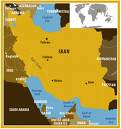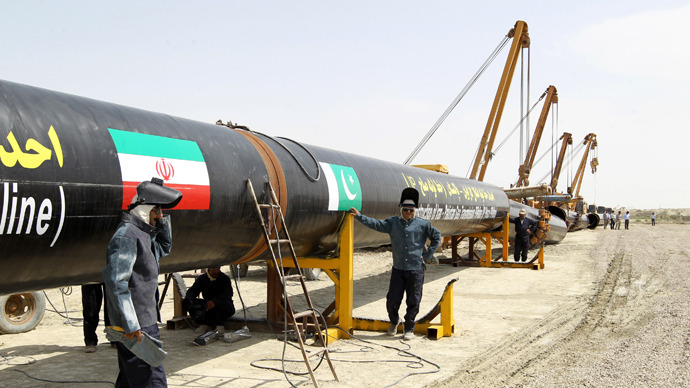Pipelineistan Geopolitics at Work: Iran, Pakistan, Syria, Qatar.

Construction is nearing completion on a natural gas pipeline linking Iran and Pakistan, a project that portends a huge geopolitical shift. As regional powers strengthen ties in this key energy market, they’re looking to China, and away from the West.
Since the early 2000s, analysts and diplomats across Asia have been dreaming of a future Asian Energy Security Grid.
This – among other developments – is what it’s all about, the conclusion of the final stretch of the $7.5 billion, 1,100-mile natural gas Iran-Pakistan (IP) pipeline, starting from Iran’s giant South Pars field in the Persian Gulf, and expected to be online by the end of 2014.
Nobody lost money betting on Washington’s reaction; IP would put Islamabad in “violation of United Nations sanctions over [Iran’s] nuclear program.” Yet this has nothing to do with the UN, but with US sanctions made up by Congress and the Treasury Department.
Sanctions? What sanctions? Islamabad badly needs energy. China badly needs energy. And India will be extremely tempted to follow, especially when IP reaches Lahore, which is only 100 km from the Indian border. India, by the way, already imports Iranian oil and is not sanctioned for it.
All aboard the win-win train
When Iranian President Mahmoud Ahmadinejad and Pakistani President Asif Zardari met at the Iranian port of Chabahar in early March, that was a long way after IP was first considered in 1994 – then as Iran-Pakistan-India (IPI), also known as the ‘peace pipeline.’ Subsequent pressure by both Bush administrations was so overwhelming that India abandoned the idea in 2009.
IP is what the Chinese call a win-win deal. The Iranian stretch is already finished. Aware of Islamabad’s immense cash flow problems, Tehran is loaning it $500 million, and Islamabad will come up with $1 billion to finish the Pakistani section. It’s enlightening to note that Tehran only agreed to the loan after Islamabad certified it won’t back out (unlike India) under Washington pressure.
IP, as a key umbilical (steel) cord, makes a mockery of the artificial – US-encouraged – Sunni-Shia divide. Tehran needs the windfall, and the enhanced influence in South Asia. Ahmadinejad even cracked that “with natural gas, you cannot make atomic bombs.”
Zardari, for his part, boosted his profile ahead of Pakistan’s elections on May 11. With IP pumping 750 million cubic feet of natural gas into the Pakistani economy everyday, power cuts will fade, and factories won’t close. Pakistan has no oil. It may have huge potential for solar and wind energy, but no investment capital and knowhow to develop them.
Politically, snubbing Washington is a certified hit all across Pakistan, especially after the territorial invasion linked to the 2011 targeted assassination of Bin Laden, plus Obama and the CIA’s non-stop drone wars in the tribal areas.
Moreover, Islamabad will need close cooperation with Tehran to assert a measure of control of Afghanistan after 2014. Otherwise an India-Iran alliance will be in the driver’s seat.
Washington’s suggestion of a Plan B amounted to vague promises to help building hydroelectric dams; and yet another push for that ultimate ‘Pipelineistan’ desert mirage – the which has existed only on paper since the Bill Clinton era.
The Foreign Office in Islamabad argued for Washington to at least try to show some understanding. As for the lively Pakistani press, it is having none of it.

The big winner is… China
IP is already a star protagonist of the New Silk Road(s) – the real thing, not a figment of Hillary Clinton’s imagination. And then there’s the ultra-juicy, strategic Gwadar question.
Islamabad decided not only to hand over operational control of the Arabian Sea port of Gwadar, in ultra-sensitive southwest Balochistan, to China; crucially, Islamabad and Beijing also signed a deal to build a $4 billion, 400,000 barrels-a-day oil refinery, the largest in Pakistan.
Gwadar, a deepwater port, was built by China, but until recently, the port’s administration was Singaporean.
The long-term Chinese master plan is a beauty. The next step after the oil refinery would be to lay out an oil pipeline from Gwadar to Xinjiang, parallel to the Karakoram highway, thus configuring Gwadar as a key Pipelineistan node distributing Persian Gulf oil and gas to Western China – and finally escaping Beijing’s Hormuz dilemma.
Gwadar, strategically located at the confluence of Southwest and South Asia, with Central Asia not that far, is bound to finally emerge as an oil and gas hub and petrochemical center – with Pakistan as a crucial energy corridor linking Iran with China. All that, of course, assuming that the CIA does not set Balochistan on fire.
The inevitable short-term result anyway is that Washington’s sanctions obsession is about to be put to rest at the bottom of the Arabian Sea, not far from Osama bin Laden’s corpse. And with IP probably becoming IPC – with the addition of China – India may even wake up, smell the gas, and try to revive the initial IPI idea.
The Syrian Pipelineistan angle
This graphic Iranian success in South Asia contrasts with its predicament in Southwest Asia.
The South Pars gas fields – the largest in the world – are shared by Iran and Qatar. Tehran and Doha have developed an extremely tricky relationship, mixing cooperation and hardcore competition.
The key (unstated) reason for Qatar to be so obsessed by regime change in Syria is to kill the $10 billion Iran-Iraq-Syria pipeline, which was agreed upon in July 2011. The same applies to Turkey, because this pipeline would bypass Ankara, which always bills itself as the key energy crossroads between East and West.

It’s crucial to remember that the Iran-Iraq-Syria pipeline is as anathema to Washington as IP. The difference is that Washington in this case can count on its allies Qatar and Turkey to sabotage the whole deal.
This means sabotaging not only Iran but also the ‘Four Seas’ strategy announced by Syrian President Bashar al-Assad in 2009, according to which Damascus should become a Pipelineistan hub connected to the Caspian Sea, the Black Sea, the Persian Gulf and the Eastern Mediterranean.
The strategy spells out a Syria intimately connected with Iranian – and not Qatari – energy flows. Iran-Iraq-Syria is known in the region as the ‘friendship pipeline.’ Typically, Western corporate media derides it as an ‘Islamic’ pipeline. (So Saudi pipelines are what, Catholic?) What makes it even more ridiculous is that gas in this pipeline would flow to Syria and then Lebanon – and from there to energy-starved European markets close by.
The Pipelineistan games get even more complicated when we add the messy Iraqi Kurdistan/Turkey energy love affair – detailed here by Erimtan Can – and the recent gas discoveries in the Eastern Mediterranean involving territorial waters of Israel, Palestine, Cyprus, Egypt, Lebanon and Syria; some, or perhaps all of these actors could turn from energy importers to energy exporters.
Israel will have a clear option to send its gas via a pipeline to Turkey, and then export it to Europe; that goes a long way to explain the recent phone call schmoozing between Turkey’s Prime Minister Erdogan and Israel’s Netanyahu, brokered by Obama.
Terrestrial and maritime borders between Israel and Lebanon remain dependent on a hazy UN Blue Line, set up way back in 2000. Damascus – as well as Tehran – supports Beirut, once again against Washington’s will. And Damascus also supports Baghdad’s strategy of diversifying its means of distribution, once again trying to escape the Strait of Hormuz. Thus, the importance of the Iran-Iraq-Syria pipeline.
No wonder Syria is a red line for Tehran. Now the whole of Pipelineistan will be watching how far Qatar is willing to go following Washington’s obsession.


